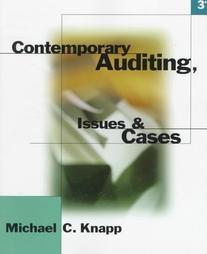Question
Brothers Mike and Tim Hargen began operations of their tool and die shop (H & H Tool, Inc.) on January 1, 2016. The annual reporting
Brothers Mike and Tim Hargen began operations of their tool and die shop (H & H Tool, Inc.) on January 1, 2016. The annual reporting period ends December 31. The trial balance on January 1, 2017, follows:
| Account Titles | Debit | Credit | |||||
| Cash | 5,000 | ||||||
| Accounts receivable | 4,000 | ||||||
| Supplies | 13,000 | ||||||
| Land | |||||||
| Equipment | 80,000 | ||||||
| Accumulated depreciation (on equipment) | 10,000 | ||||||
| Other assets (not detailed to simplify) | 9,000 | ||||||
| Accounts payable | |||||||
| Wages payable | |||||||
| Interest payable | |||||||
| Income taxes payable | |||||||
| Long-term notes payable | |||||||
| Common stock (8,000 shares, $.50 par value) | 4,000 | ||||||
| Additional paid-in capital | 82,000 | ||||||
| Retained earnings | 15,000 | ||||||
| Service revenue | |||||||
| Depreciation expense | |||||||
| Supplies expense | |||||||
| Wages expense | |||||||
| Interest expense | |||||||
| Income tax expense | |||||||
| Remaining expenses (not detailed to simplify) | |||||||
| Totals | 111,000 | 111,000 | |||||
|
| |||||||
Transactions during 2017 follow:
Borrowed $24,000 cash on a 5-year, 10 percent note payable, dated March 1, 2017.
Purchased land for a future building site on March 15, 2017; paid cash, $13,000.
Earned $231,000 in revenue. Transactions dated August 30, 2017 , including $51,000 on credit and the rest in cash.
Sold 4,000 additional shares of capital stock for cash at $1 market value per share on January 1, 2017.
Incurred $118,000 in remaining expenses for 2017, invoices dated October 15, 2017, including $22,000 on credit and the rest paid in cash.
Collected accounts receivables on November 10, 2017, $36,000.
Purchased other assets on November 15, 2017, $13,000 cash.
Purchased supplies on account for future use on December 1, 2017, $25,000.
Paid accounts payable on December 15, 2017, $24,000.
Signed a three-year $31,000 service contract on December 17, 2017 to start February 1, 2018.
Declared and paid cash dividends on December 20, 2017, $23,000.
Data for adjusting entries:
Supplies counted on December 31, 2017, $16,000.
Depreciation for the year on the equipment, $12,000.
Interest accrued on notes payable (to be computed).
Wages earned by employees since the December 24 payroll but not yet paid, $15,000.
Income tax expense, $11,000, payable in 2018.
Prepare journal entries for transactions (a) through (k).
Prepare the adjusting entries for transactions (l) through (p)
Post the journal entries for transactions (a) through (k) and adjusting entries for transactions (l) through (p) to the respective T-Accounts.
Prepare an income statement (including earnings per share), statement of stockholders equity, and balance sheet.
Identify the type of transaction for (a) through (k) for the statement of cash flows (O for operating, I for investing, F for financing), and the direction and amount of the effect. (List cash outflows as negative amounts. For transactions with no effect, choose "NE".)
Prepare the closing entry on December 31, 2017. (If no entry is required for a transaction/event, select "No journal entry required" in the first account field. After recording this closing entry, post the entry to the General Ledger in Part (3).)
Compute the current ratio for 2017. (Round your answer to 2 decimal places.)
Compute the total asset turnover ratio for 2017.
Compute the net profit margin ratio for 2017.
Step by Step Solution
There are 3 Steps involved in it
Step: 1

Get Instant Access to Expert-Tailored Solutions
See step-by-step solutions with expert insights and AI powered tools for academic success
Step: 2

Step: 3

Ace Your Homework with AI
Get the answers you need in no time with our AI-driven, step-by-step assistance
Get Started


